Introduction
High-protein tropical smoothies are the ideal option if you want a tasty and healthy approach to start your day or replenish following an exercise. They not only supply the nutrients and energy your body needs, but they also give your everyday taste of the tropics. Rich, juicy mangoes form a great basis for these smoothies since they naturally sweeten high-protein foods and blend wonderfully with other components. We’ll provide five mouthwatering high-protein mango smoothies on this blog that will satisfy your nutritional needs and offer a tropical lift.
The Nutritional Power of Mangoes
Why Mangoes are a Tropical Superfruit
Mangoes have earned the title of the “king of fruits” for good reason. They are rich in essential vitamins, minerals, and antioxidants, promoting general health. High in vitamin C, mangoes strengthen iron absorption, boost the immune system, and support good skin. They also include fiber, which prolongs feeling full and aids with digestion. Mangoes’ natural sweet taste makes them ideal for smoothies, therefore lowering the need for additional sugar and providing a tropical, refreshing taste.
Mangoes and Protein: A Perfect Pairing
Although mangoes offer a lot of nutrients, combining them with foods heavy in protein enhances their health effects. Building and mending tissues, generating hormones and enzymes, and supporting general muscular health all depend on protein. Including protein in your mango smoothie makes a balanced meal that fuels your body, promotes recovery following exercise, and helps to preserve a healthy weight.
Why High-Protein Smoothies are Essential
Protein’s role in muscle development and recovery
Particularly following vigorous physical activity, protein is absolutely essential for muscle healing and growth. Exercise causes minor tears in your muscles, which require healing. Protein helps your muscles get stronger over time because it serves as the building blocks—or amino acids—needed for this healing process. Including high-protein smoothies in their diet will ensure that those who are active or trying to grow muscle get enough protein to support these processes. Check out this comprehensive guide by the Harvard T.H. Chan School of Public Health.
Protein Smoothies for Loss Control
High-protein smoothies are also great for weight management. Protein is more satiating than carbohydrates or fats, which prolongs feelings of fullness. Starting your day with a high-protein tropical smoothie or savoring one as a snack will help you lower cravings and eventually consume fewer calories throughout the day. High-protein smoothies are therefore an excellent tool for anyone trying to lose weight or maintain a healthy weight.
Recipe 1: Classic Mango and Greek Yogurt High-Protein Smoothie
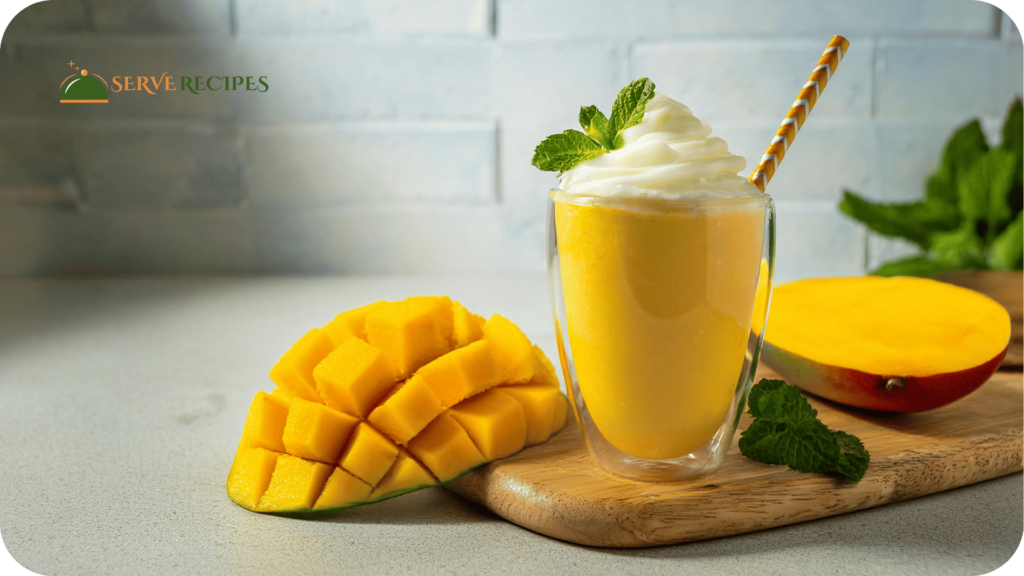
Ingredients
- 1 ripe mango, peeled and diced
- 1 cup Greek yogurt (plain or vanilla)
- 1/2 cup almond milk (or milk of choice)
- 1 tablespoon honey or maple syrup (optional)
- 1/2 teaspoon vanilla extract
- Ice cubes (optional)
Instructions
- Put the chopped mango, Greek yogurt, almond milk, honey, and vanilla essence into a blender.
- Blend on high until creamy and smooth.
- If wanted, add ice cubes; mix once more until smooth.
- Pour it into a glass and sip away!
Nutritional Breakdown
| Calories | Protein | Carbohydrates | Fat |
| 250 | 20g | 35g | 5g |
This smoothie offers a balanced mix of protein, carbohydrates, and fats, making it ideal for muscle repair and overall health. To understand the broader benefits of protein in your diet, you can refer to this Mayo Clinic article on protein in the diet.
Recipe 2: Tropical Mango and Almond Butter Smoothie
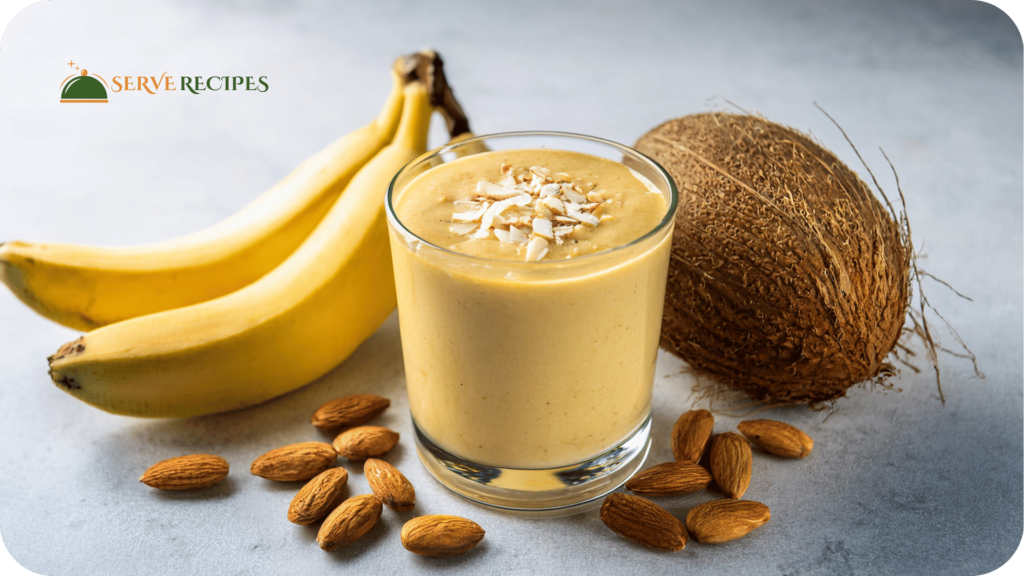
Ingredients
- 1 ripe mango, peeled and diced
- 1 tablespoon almond butter
- 1 scoop vanilla protein powder
- 1/2 cup coconut milk
- 1/4 cup rolled oats
- Ice cubes
Instructions
- In a blender, combine the mango, almond butter, protein powder, coconut milk, and oats.
- Blend until smooth and creamy.
- Add ice cubes and once more blend until well combined.
- Enjoy the tropical tastes presented in a glass!
Nutritional Breakdown
| Calories | Protein | Carbohydrates | Fat |
| 300 | 22g | 40g | 10g |
Recipe 3: Mango and Spinach Protein-Packed Smoothie
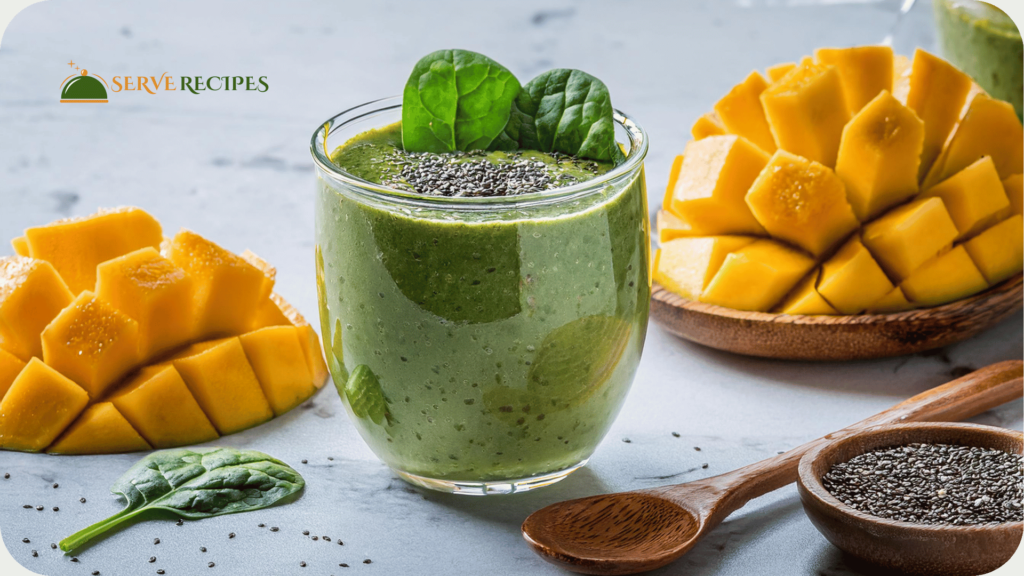
Ingredients
- 1 ripe mango, peeled and diced
- 1 handful of fresh spinach
- 1 scoop unflavored or vanilla protein powder
- 1/2 banana
- 1/2 cup unsweetened almond milk
- 1 tablespoon chia seeds
- Ice cubes
Instructions
- To a blender, add the mango, spinach, protein powder, banana, almond milk, and chia seeds.
- Blend until very thoroughly integrated and smooth.
- For a thinner, cooler smoothie, add ice cubes; mix once more.
- Present in a glass, savor the goodness contained in nutrients!
Nutritional Breakdown
| Calories | Protein | Carbohydrates | Fat |
| 270 | 24g | 40g | 6g |
Recipe 4: Mango and Coconut Protein Smoothie
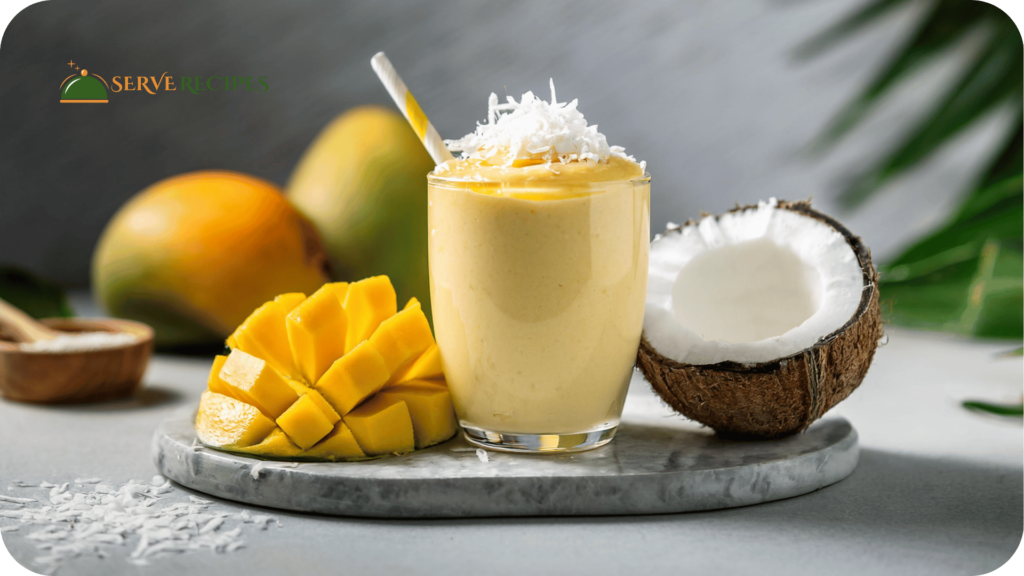
Ingredients
- 1 ripe mango, peeled and diced
- 1/2 cup coconut water
- 1/4 cup unsweetened coconut yogurt
- 1 scoop coconut-flavored protein powder
- 1 tablespoon shredded coconut (optional)
- Ice cubes
Instructions
- In a blender, toss the mango, coconut water, coconut yogurt, and protein powder.
- Blend on high until the mixture comes together smooth and creamy.
- If desired, add shredded coconut; mix once more.
- Pour it into a glass and enjoy the tropical taste of coconut and mango!
Nutritional Breakdown
| Calories | Protein | Carbohydrates | Fat |
| 260 | 21g | 35g | 8g |
Recipe 5: Mango and Chia Seed High-Protein Smoothie
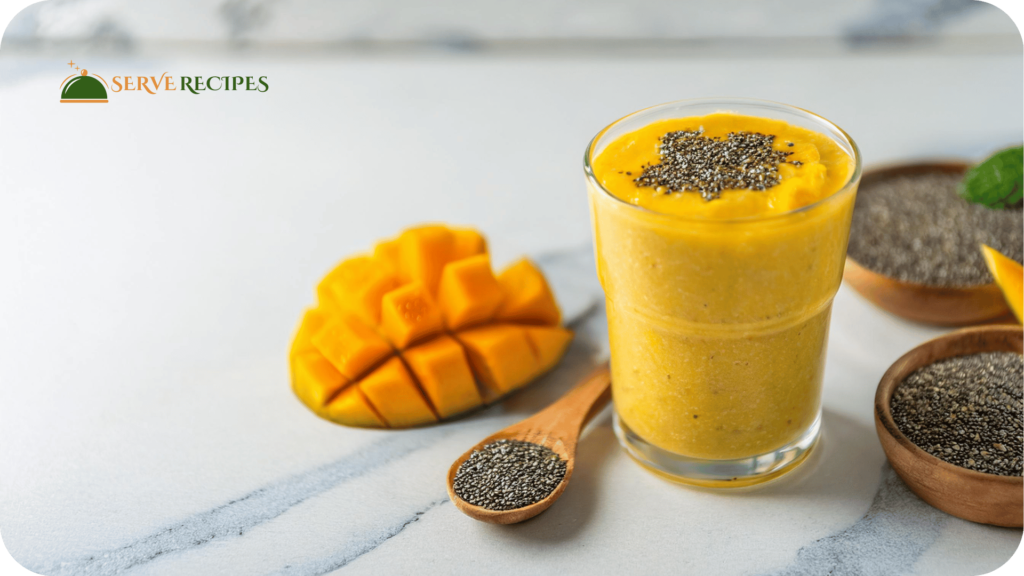
Ingredients
- 1 ripe mango, peeled and diced
- 1 tablespoon chia seeds
- 1/2 cup Greek yogurt (plain or vanilla)
- 1/2 cup unsweetened almond milk
- 1 scoop vanilla protein powder
- Ice cubes
Instructions
- In a blender, mix the mango, chia seeds, Greek yogurt, almond milk, and protein powder.
- Blend until very well combined and smooth.
- To thin and chill the smoothie, toss ice cubes; then, mix once more.
- Present it right away as a revitalizing, high-protein beverage!
Nutritional Breakdown
| Calories | Protein | Carbohydrates | Fat |
| 280 | 25g | 32g | 8g |
Tips for Customizing Your High-Protein Mango Smoothies
Adding Extra Protein
There are a variety of items you can add to your smoothies to increase the protein level even further. A quick and simple approach to raising protein levels is with protein powders, including soy, pea, and whey. You might also use chia seeds, flaxseeds, almond butter, peanut butter, or even silken tofu for a smoothie loaded with proteins.
Adjusting Sweetness and Texture
Though mangoes are naturally sweet, consider adding some honey, maple syrup, or a few dates if you would like a sweeter smoothie. Add extra liquid for a thinner consistency; oats or additional yogurt will transform the texture into a richer, creamier smoothie.
Vegan and Dairy-Free Options
For individuals on a vegan or dairy-free diet, these dishes are quite flexible. Replace Greek yogurt with plant-based yogurt created from almonds, coconuts, or cashews. Replace dairy milk with plant-based milk substitutes, such as soy, oat, or almond milk. These changes will satisfy dietary restrictions and maintain your smoothies’ high protein content.
Health Benefits of Regularly Consuming High-Protein Smoothies
Improved Muscle Health
Drinking high-protein tropical smoothies on a regular basis will greatly improve your muscle condition. Particularly following exercise, the protein helps muscles heal and grow stronger over time, so ensuring efficient recovery of your muscles.
Enhanced Energy Levels
These smoothies give a steady energy boost in addition to helping with muscle repair. Protein, fiber, and beneficial carbohydrates together guarantee that you will have the energy you need to run through your day without the crash sometimes associated with sugary snacks.
Better Digestion and Gut Health
Mangoes are high in fiber, which together with the protein in these smoothies aids in improved digestion. General well-being depends on a healthy digestive system; hence, the fiber supports regular bowel movements and feeds helpful gut flora, thereby preserving a healthy gut.
Regularly consuming high-protein tropical smoothies can significantly contribute to a balanced diet, aiding in muscle health, energy levels, and digestion. For a more in-depth look at maintaining a healthy diet, visit the World Health Organization’s guide on healthy eating.
Frequently Asked Questions
Can I Use Frozen Mangos Instead of Fresh?
You certainly could substitute frozen mangoes for fresh ones. Because they don’t require peeling and slicing, frozen mangoes are typically more practical and nutritious. Frozen mangoes can also add thickness and cooler consistency to your smoothie.
What Are Some Good Protein Add-Ins for Smoothies?
Apart from the components included in the recipes, other excellent sources of protein are hemp seeds, unsweetened cocoa powder, Greek yogurt, and nut butters with a high protein count. These add-ins can improve your smoothies’ taste and protein load.
How Long Can I Store These Smoothies?
While you should consume smoothies immediately after preparation to fully appreciate their nutritional value, you can store them in an airtight container in the refrigerator for up to twenty-four hours. If separation is observed, simply give the smoothie a quick shake or mix before consumption.
Are These Smoothies Suitable for Post-Workout Recovery?
Correct! Post-workout recuperation calls for these high-protein tropical smoothies. Along with carbohydrates from mangoes to restore glycogen levels, they offer the protein required for muscle repair and growth, therefore facilitating faster and more effective recovery.
Can I Use a Different Fruit Instead of Mango?
If mangoes are not in season, you can substitute another fruit such as pineapple, papaya, or peaches. Still, keep in mind that this will somewhat change the taste and nutritional balance of the smoothie.
Conclusion
Including high-protein mango smoothies in your diet is a great way to satisfy your taste and support your health objectives at the same time. These smoothie ideas provide a great mix of taste and nutrients, whether your goals are weight management, muscular building, or just a nice tropical boost. Be creative and adapt the recipes to your tastes. Your body will appreciate the healthy and reviving beginning to your daily life!
For more high-protein smoothies, checkout our smoothie recipes:
